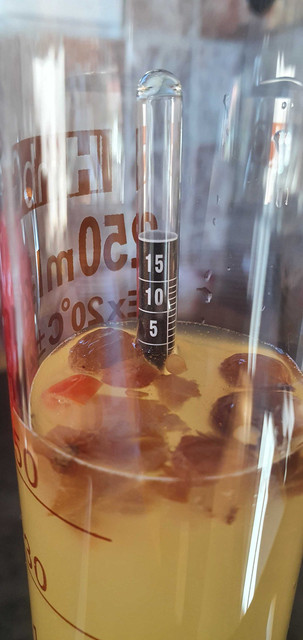elephant
Well-Known Member
- Joined
- Nov 1, 2020
- Messages
- 48
- Reaction score
- 8
Hello...
I've never brewed anything before. I stumbled across a YouTube video on how to make mead (linked below) and thought I'd give it a shot. I will update this thread with my progress.
I've made two gallon jugs, the first one I did pretty much to the recipe that used. I made a mistake in not being super precise with the honey measurement, I didn't think it mattered that much. I think I put about 1.4kg (2.8lbs) in the first one anyway. I put a 1kg bag and then a bit less than 1/2 of another 1kg bag. So I was kind of winging it, but after reading a bit more about it later, I guess I should have been more precise.
The second gallon jug I wanted to experiment a bit, so I only put about 1.1kg (2.4lbs) of honey, and also added some smokey tea, some chilli, orange zest and cinnamon powder. I have no idea what I'm doing I just like experimenting.
The original gravity for the first one (after the bubbles settled down) ended up being 1.100 and the original gravity for the second one is 1.084. So from what I can gather from my reading, a bit low on the first one and quite a bit low on the second one, but I prefer it a little drier and not as strong anyway, and it's all for experimentation so I will stick with that.
I plan to make another two gallon jugs as well. In one of them I'm just going to use 1.5kg of honey and nothing else, just to use as a "control" so I can see how my other experiments are changing it. And in the fourth one, I'm not sure yet. I'll think of something interesting.
I've never brewed anything before. I stumbled across a YouTube video on how to make mead (linked below) and thought I'd give it a shot. I will update this thread with my progress.
I've made two gallon jugs, the first one I did pretty much to the recipe that used. I made a mistake in not being super precise with the honey measurement, I didn't think it mattered that much. I think I put about 1.4kg (2.8lbs) in the first one anyway. I put a 1kg bag and then a bit less than 1/2 of another 1kg bag. So I was kind of winging it, but after reading a bit more about it later, I guess I should have been more precise.
The second gallon jug I wanted to experiment a bit, so I only put about 1.1kg (2.4lbs) of honey, and also added some smokey tea, some chilli, orange zest and cinnamon powder. I have no idea what I'm doing I just like experimenting.
The original gravity for the first one (after the bubbles settled down) ended up being 1.100 and the original gravity for the second one is 1.084. So from what I can gather from my reading, a bit low on the first one and quite a bit low on the second one, but I prefer it a little drier and not as strong anyway, and it's all for experimentation so I will stick with that.
I plan to make another two gallon jugs as well. In one of them I'm just going to use 1.5kg of honey and nothing else, just to use as a "control" so I can see how my other experiments are changing it. And in the fourth one, I'm not sure yet. I'll think of something interesting.
Last edited:










































![Craft A Brew - Safale S-04 Dry Yeast - Fermentis - English Ale Dry Yeast - For English and American Ales and Hard Apple Ciders - Ingredients for Home Brewing - Beer Making Supplies - [1 Pack]](https://m.media-amazon.com/images/I/41fVGNh6JfL._SL500_.jpg)















